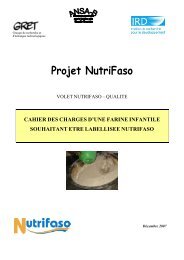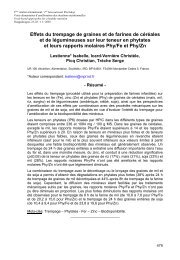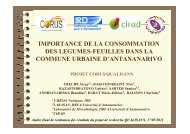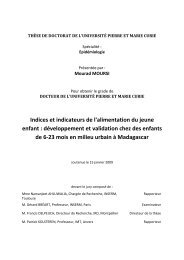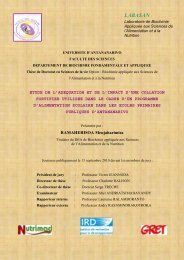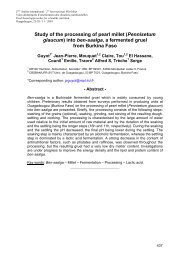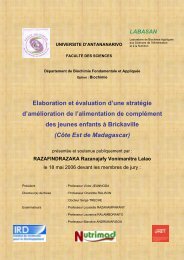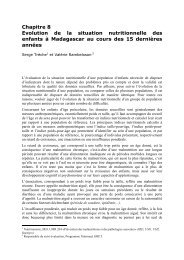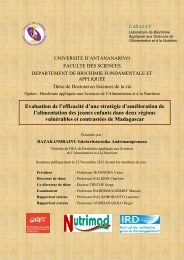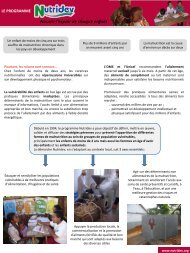THESE UNIQUE El Hassane Kéhien-Piho TOU - Nutridev
THESE UNIQUE El Hassane Kéhien-Piho TOU - Nutridev
THESE UNIQUE El Hassane Kéhien-Piho TOU - Nutridev
You also want an ePaper? Increase the reach of your titles
YUMPU automatically turns print PDFs into web optimized ePapers that Google loves.
Projet d’article<br />
(24%) followed by Lb plantarum (14%) and<br />
Pediococcus pentosaceus (12%).<br />
1. Introduction<br />
Numerous fermented foods consumed<br />
throughout the world are cereal-based foods<br />
produced by natural fermentation (Blandino<br />
et al., 2003). Several studies reported that<br />
cereal-based fermented foods have good<br />
nutritional properties (Nout 1991;<br />
Hounhouigan et al., 1993; Kingamkono et al.,<br />
1994; Svanberg and Lorri, 1997) and sanitary<br />
characteristics (Odunfa and Adeyele, 1985;<br />
Nout et al., 1989; Mensah et al., 1991; Lei<br />
and Jakobsen, 2004) attributed to natural<br />
lactic acid bacteria. There are various<br />
indigenous fermented foods and a great deals<br />
of data are available on these foodstuffs: koko<br />
(Lei and Jakobsen, 2004), kenkey (Olasupo et<br />
al. 1997; Hayford et al. 1999), mawè<br />
(Hounhouigan et al. 1993 ; 1994), ogi<br />
(Johansson et al. 1995; Olasupo et al. 1997),<br />
ogi-baba (Odunfa and Adeyele 1985),<br />
hussuwa (<strong>El</strong> Nour et al. 1999), kisra (Hamad<br />
et al. 1992), kanu-zarki (Olasupo et al. 1997),<br />
kamu (Oyeyiola 1991), ambali (Antony and<br />
Chandra 1997), obiolor (Achi 1990), sigda<br />
(<strong>El</strong>faki et al. 1991) and ben-saalga (Ben<br />
Omar et al, 2006; Tou et al, 2006).<br />
Keywords: pearl millet, traditional<br />
fermentation, complementary food, lactic<br />
acid bacteria, phenotypic characterization<br />
In Ouagadougou (Burkina Faso), fermented<br />
gruels traditionally consumed are produced<br />
from millet and are often used as<br />
complementary foods. These millet-based<br />
fermented gruels are called ben-saalga or<br />
ben-kida in mooré (popular language in<br />
Burkina Faso) and koko in dioula. At the<br />
difference of ben-saalga, ben-kida was<br />
characterised by the presence of granules.<br />
Ben-saalga or ben-kida is produced in small<br />
scale producing units which are widespread<br />
in Ouagadougou. These producing units are<br />
often cottage or family micro-enterprises. As<br />
reported by a preliminary survey<br />
(unpublished data), young children preferred<br />
ben-saalga, because it is a thin gruel,<br />
whereas, adults largely consumed ben-kida<br />
for breakfast. Preparation of these gruels is an<br />
old practice well-known by the producers.<br />
Gruels are sold in a ready-to-eat form, early<br />
in the morning in front of the producer’s<br />
homes or on the street. Surveys reported that<br />
49 % of households in Ouagadougou eat<br />
these fermented gruels. In the households<br />
considered as regular consumers, 75 % of<br />
children less than 5 years old are regularly<br />
fed with these gruels (Cerefer, 2003). Study<br />
of the processing of pearl millet into ben-<br />
73



